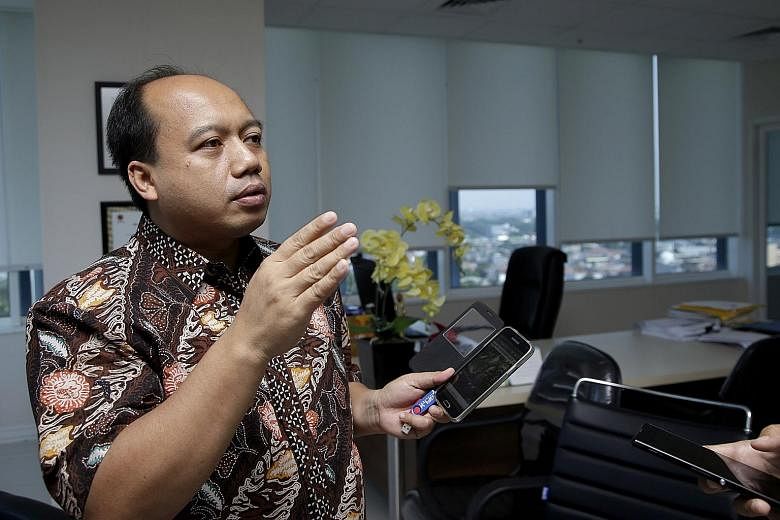An earthquake of magnitude 6.3 strikes the eastern Indonesian island of Alor on Wednesday.
Two days later, a Boeing 737 passenger jet skids off a runway in Yogyakarta's Adisucipto Airport.
Thousands of people remain stranded at other terminals across the eastern part of Indonesia, after hundreds of flights were delayed over the weekend due ash clouds from a volcanic eruption in Lombok last month.
All that even as relief operations continue in Kalimantan and Sumatra, as millions in South-east Asia wait with bated breath, wondering if the haze crisis is finally over.
That in a nutshell is Dr Sutopo Purwo Nugroho's week. Want proof? Follow him on Twitter, where he is usually first with an alert in the event of a disaster, followed by an analysis of the situation.
As head of data and information at Indonesia's National Disaster Management Agency (BNPB), it is his job to be on top of such incidents so that the Indonesian government can make informed decisions as it coordinates relief or rescue efforts.
"When disaster strikes, I immediately need to know 'who, when, what, why and how', so that we can plan what next," said Dr Sutopo.
The 46-year-old is arguably the single most quoted official in the media during this year's haze crisis.
This after he developed a reputation for being a straight-shooter when it comes to sharing information with the media and public - instead of allowing bureaucracy to dilute or, worse, bury the facts.
"I choose to tell the public what is really happening on the ground because people should know the truth," he said during an interview with The Straits Times at the BNPB headquarters on Friday. "Also, in this age of transparency, where there are so many media outlets, we would look funny if we try to cover things up."
His weapon of choice as the de facto spokesman for the agency is social media because the battleground for information is the Internet, where he said facts can often be misconstrued, leaving people with more questions than answers.
That is why he regularly shares raw information - from air pollution levels to satellite images of wind and weather patterns, to photos and videos of relief operations - via platforms such as Twitter, Blackberry Messenger (BBM) and WhatsApp.
But to remain credible, he makes it a point not to self-censor and avoids delivering only sanitised versions of the truth, said Dr Sutopo.
An example of him walking the talk is a photo he tweeted recently. It showed oil palm seedlings lining up neatly over an orang utan sanctuary in Central Kalimantan, which had just been cleared by fire.
The photo, shared by users of Twitter, Facebook and Instagram, went viral. It was also picked up by Greenpeace, but it was quickly refuted by Indonesia's palm oil trade association, which claimed it was a victim of a smear campaign.
"When we broadcast to the public, it assures people that the government is aware and on top of things," added Dr Sutopo.
An alumnus of Gadjah Mada University in Yogyakarta and Bogor Agriculture Institute, where he completed his PhD in natural resources and environment management, he became the voice of BNPB by chance.
"In my first year at BNPB, there were three disasters, but we had no one who understood disaster management and could handle the media at the same time," he said.
"And we really felt that it was important for BNPB to disclose information on the incidents to the public in a more timely manner."
In the early days, Dr Sutopo would call for briefings at BNPB, but his openness made him the first phone call for journalists whenever a crisis breaks, he said. "Disasters in Indonesia have a habit of happening on weekends, when offices are closed, but I'm not closed and my friends in the media know that and, very often, a TV crew will appear outside my house with their (mobile satellite vehicle) waiting for me to say something," said Dr Sutopo.
"The roads in my neighbourhood are narrow, so I felt guilty that my neighbours are disturbed, but they now understand."
He quickly recognised that, instead of being a threat, social media can be a "force multiplier" and as BBM was the communique of choice for most people in Indonesia, why not use it to broadcast updates, he thought.
Dr Sutopo has since evolved his communications operations and, as the agency's spokesman, now manages several chat groups on WhatsApp and BBM, comprising colleagues from BNPB and others from the police, military and ministries, as well as hundreds of journalists.
Carrying multiple mobile phones is also now par for the course for him and his team of 28, comprising many young graduates who he mentors. "I won't be here in this position forever," he said.
"My staff are the future leaders, so I have to share knowledge and whatever I know with them."
Although he is now at the peak of his career in the civil service, he wants junior officers to remember that their obligation is still to the people and he has a story on how no task is too small, even for a senior official such as himself.
"One day, an elderly woman in Yogyakarta called me to say her cat had climbed up a tree and would not come back down, and asked for help," he quipped. "So I sent a team in to help her and the cat was rescued. We do these things too."

